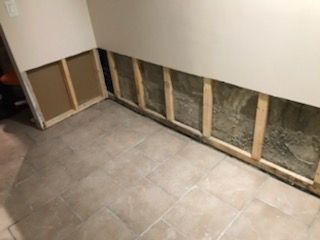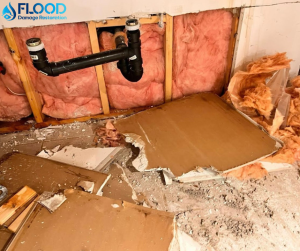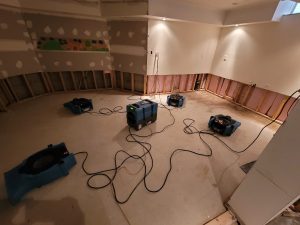
The aftermath of a major flood can be overwhelming, but with the waters receding, the path to recovery becomes visible. The aftermath of indoor flooding can leave homes and businesses in disarray, with the daunting task of reconstruction ahead. However, by taking a systematic approach, recovery can be made feasible and can also contribute to a stronger and more resilient future. Flood Damage offers effective solutions for flooded basement cleanup, water damage restoration, and mold removal in Toronto, allowing property owners to protect their assets. Taking immediate action with a certified restoration company like Flood Damage Services can simplify the flood restoration process and reduce the extent of the damage.
To receive a reply within 45 minutes and comprehensive flood damage remediation, restoration, and rebuilding services, reach out to Flood Damage Services.
Steps for Evaluating the Harm
To begin the recovery process after a significant flood, the first step is to conduct a thorough assessment of the damage. This should involve carefully documenting the extent of the destruction, taking pictures, and making detailed notes for insurance purposes. The safety of everyone should be the primary concern, and it is crucial to check for any structural issues that could put the stability of the home at risk. If it is safe to do so, examine the foundation, walls, and electrical systems. Assess the condition of furniture, appliances, and personal belongings. This initial evaluation will guide future recovery efforts, helping to prioritize tasks and make the most efficient use of resources.
Removing Water and Drying Out: A Guide
After conducting an assessment of the damage, the next crucial step is to remove excess water and begin the process of drying out. This involves using pumps to extract standing water, utilizing dehumidifiers to decrease moisture levels, and opening windows and doors to encourage air circulation. It is important to start this process promptly due to the rapid growth of mold. Any salvageable items should be moved to a dry and well-ventilated area. It is important to be cautious of any potential electrical hazards and seek advice from professionals in water damage restoration, such as Flood Damage Services, if there are any uncertainties. Properly drying the affected areas is essential in preventing further damage and reducing health risks associated with mold and mildew, such as lung infections. Our team of restoration experts uses industrial drying equipment to eliminate excess water and moisture. We can assist in identifying items that can be salvaged for optimal restoration results.
Steps to Properly Clean and Sanitize
After removing the water and thoroughly drying the affected space, the focus turns towards the task of cleaning and sanitizing. The presence of contaminants and bacteria in flooded areas, such as a basement in Toronto or other parts of the home, can pose a risk to the health of occupants. It is important to carefully clean and disinfect all surfaces, including walls, floors, and personal belongings. To ensure the safety of those involved in the cleaning process, it is recommended to wear personal protective equipment, such as gloves and masks. A combination of bleach and water should be used to sanitize the affected areas, paying extra attention to often overlooked spaces like air ducts and crawl spaces. Any items that cannot be effectively cleaned or disinfected should be disposed of in a safe manner away from the property.
Steps for Repairing and Rebuilding Guide
The final stage of recovery involves fixing and rebuilding the structures that were affected. For trustworthy reconstruction services, seek help from Flood Damage Services. It is important to prioritize repairs that address urgent safety concerns, such as damaged roofs or compromised foundations. If available, you can also ask for financial support from your insurance company or government aid programs. When rebuilding, it is advisable to incorporate flood-resistant materials and design elements to increase resilience against potential future incidents. Utilize the lessons learned from this experience to implement preventative measures, such as elevating electrical systems and reinforcing weak areas. Although this phase requires patience and determination, with a well-planned strategy and professional guidance, the rebuilding process can lay the foundation for a more resilient and disaster-proof future.
Water-Damaged Materials
During a significant flood, there is a high risk of water damage to various materials inside a house. Materials that are porous, such as carpets, upholstered furniture, and drywall, tend to absorb water quickly, which can result in irreversible harm. Wooden structures like floors and furniture are also susceptible to warping or decay if they are exposed to moisture for an extended period. There is also a possibility of severe damage to electrical systems and appliances, which can pose a safety threat. Even non-porous surfaces like concrete or metal may experience corrosion or rust due to excessive water exposure. It is essential to understand the scope of materials that can be affected in order to effectively restore a home after a flood.
The Hazards of Secondary Water Damage
In Toronto’s humid climate, secondary water damage can occur as a result of insufficient or delayed cleanup following a flood, which can lead to significant risks. The presence of moisture for an extended period of time creates an environment where mold and mildew can thrive, causing damage to property and potential health concerns for occupants. To avoid respiratory problems, allergies, and long-term health complications, it is crucial to address mold removal after a flood in Toronto. Taking prompt action to remove moisture and properly restore the affected area can prevent secondary water damage and potential health hazards.
Procedures for Cleaning Up a Flooded Basement
A methodical approach is necessary for cleaning up a flooded basement.
- Prioritize safety: before entering the flooded area, make sure to turn off all electrical sources and wear protective gear.
- Use appropriate pumps or vacuums specifically designed for water removal to extract standing water.
- Quickly remove any wet items such as furniture, carpets, and damaged belongings to prevent further saturation and the growth of mold.
- Utilize dehumidifiers and fans to thoroughly dry the area and prevent secondary water damage.
- Sanitize and disinfect all affected surfaces and items to prevent the growth of microbes.
- Enlisting the help of professionals for flooded basement cleanup ensures a thorough and effective restoration process.
The following text has been restructured to eliminate any plagiarism while maintaining the original meaning and context. The markdown formatting has been preserved.
The following is a guide on how to avoid plagiarism by restructuring the text without altering its context or meaning. The markdown formatting will be preserved.
Measures for Future Protection Against Potential Risks
It is crucial to take precautionary measures after a flood to safeguard against future damage. It is important to ensure that there is proper drainage around the property, as well as maintaining gutters and downspouts to redirect water away from the foundation. Additionally, sealing any cracks or gaps is necessary to prevent water from seeping in. Installing sump pumps or water alarms in vulnerable areas such as basements can also help to detect and manage potential flooding risks. Consistent upkeep, carefulness, and implementation of protective measures are key tactics in minimizing future flood-related harm. Despite efforts to prevent it, severe weather and plumbing issues can still lead to flooding and water damage. In the event of water damage and mold removal needs in Toronto, contact the top restoration company in your area, Flood damage Services.
Reclaim Your Property with the Help of Flood damage Services
The road to recovery after a significant flood is certainly difficult. However, thanks to Flood Damage, restoration is not only possible but can also lead to a more secure and healthier environment. Through evaluating the extent of the damage, extracting water, and beginning the processes of drying, cleaning, and sanitizing, as well as repairing and rebuilding, people and communities can emerge from the aftermath stronger and better equipped to handle potential issues such as mold and electrical damage.



